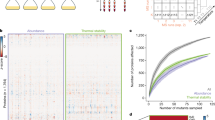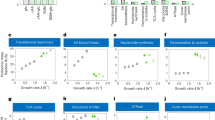Abstract
Measuring precise concentrations of proteins can provide insights into biological processes. Here we use efficient protein extraction and sample fractionation, as well as state-of-the-art quantitative mass spectrometry techniques to generate a comprehensive, condition-dependent protein-abundance map for Escherichia coli. We measure cellular protein concentrations for 55% of predicted E. coli genes (>2,300 proteins) under 22 different experimental conditions and identify methylation and N-terminal protein acetylations previously not known to be prevalent in bacteria. We uncover system-wide proteome allocation, expression regulation and post-translational adaptations. These data provide a valuable resource for the systems biology and broader E. coli research communities.
This is a preview of subscription content, access via your institution
Access options
Subscribe to this journal
Receive 12 print issues and online access
$209.00 per year
only $17.42 per issue
Buy this article
- Purchase on Springer Link
- Instant access to full article PDF
Prices may be subject to local taxes which are calculated during checkout





Similar content being viewed by others
References
Marguerat, S. et al. Quantitative analysis of fission yeast transcriptomes and proteomes in proliferating and quiescent cells. Cell 151, 671–683 (2012).
Lee, M.V. et al. A dynamic model of proteome changes reveals new roles for transcript alteration in yeast. Mol. Syst. Biol. 7, 514 (2011).
Ishihama, Y. et al. Protein abundance profiling of the Escherichia coli cytosol. BMC Genomics 9, 102 (2008).
Schwanhäusser, B. et al. Global quantification of mammalian gene expression control. Nature 473, 337–342 (2011).
Malmström, J. et al. Proteome-wide cellular protein concentrations of the human pathogen Leptospira interrogans. Nature 460, 762–765 (2009).
Beck, M. et al. The quantitative proteome of a human cell line. Mol. Syst. Biol. 7, 549 (2011).
Krug, K. et al. Deep coverage of the Escherichia coli proteome enables the assessment of false discovery rates in simple proteogenomic experiments. Mol. Cell. Proteomics 12, 3420–3430 (2013).
Li, G.-W., Burkhardt, D., Gross, C. & Weissman, J.S. Quantifying absolute protein synthesis rates reveals principles underlying allocation of cellular resources. Cell 157, 624–635 (2014).
Maddalo, G. et al. Systematic analysis of native membrane protein complexes in Escherichia coli. J. Proteome Res. 10, 1848–1859 (2011).
Masuda, T., Saito, N., Tomita, M. & Ishihama, Y. Unbiased quantitation of Escherichia coli membrane proteome using phase transfer surfactants. Mol. Cell. Proteomics 8, 2770–2777 (2009).
Macek, B. et al. Phosphoproteome analysis of E. coli reveals evolutionary conservation of bacterial Ser/Thr/Tyr phosphorylation. Mol. Cell. Proteomics 7, 299–307 (2008).
Soares, N.C., Spät, P., Krug, K. & Macek, B. Global dynamics of the Escherichia coli proteome and phosphoproteome during growth in minimal medium. J. Proteome Res. 12, 2611–2621 (2013).
Zhang, J. et al. Lysine acetylation is a highly abundant and evolutionarily conserved modification in Escherichia coli. Mol. Cell. Proteomics 8, 215–225 (2009).
Weinert, B.T. et al. Acetyl-phosphate is a critical determinant of lysine acetylation in E. coli. Mol. Cell 51, 265–272 (2013).
Colak, G. et al. Identification of lysine succinylation substrates and the succinylation regulatory enzyme CobB in Escherichia coli. Mol. Cell. Proteomics 12, 3509–3520 (2013).
Ishii, N. et al. Multiple high-throughput analyses monitor the response of E. coli to perturbations. Science 316, 593–597 (2007).
Scott, M., Klumpp, S., Mateescu, E.M. & Hwa, T. Emergence of robust growth laws from optimal regulation of ribosome synthesis. Mol. Syst. Biol. 10, 747 (2014).
Savas, J.N., Stein, B.D., Wu, C.C. & Yates, J.R. III. Mass spectrometry accelerates membrane protein analysis. Trends Biochem. Sci. 36, 388–396 (2011).
Baba, T. et al. Construction of Escherichia coli K-12 in-frame, single-gene knockout mutants: the Keio collection. Mol. Syst. Biol. 2, 0008 (2006).
Blattner, F.R. et al. The complete genome sequence of Escherichia coli K-12. Science 277, 1453–1462 (1997).
Soupene, E. et al. Physiological studies of Escherichia coli strain MG1655: growth defects and apparent cross-regulation of gene expression. J. Bacteriol. 185, 5611–5626 (2003).
Schmidt, A. et al. Absolute quantification of microbial proteomes at different states by directed mass spectrometry. Mol. Syst. Biol. 7, 510 (2011).
Picotti, P., Bodenmiller, B., Mueller, L.N., Domon, B. & Aebersold, R. Full dynamic range proteome analysis of S. cerevisiae by targeted proteomics. Cell 138, 795–806 (2009).
Gillette, M.A. & Carr, S.A. Quantitative analysis of peptides and proteins in biomedicine by targeted mass spectrometry. Nat. Methods 10, 28–34 (2013).
Ahrné, E., Molzahn, L., Glatter, T. & Schmidt, A. Critical assessment of proteome-wide label-free absolute abundance estimation strategies. Proteomics 13, 2567–2578 (2013).
Volkmer, B. & Heinemann, M. Condition-dependent cell volume and concentration of Escherichia coli to facilitate data conversion for systems biology modeling. PLoS One 6, e23126 (2011).
Akhtar, M.K. & Jones, P.R. Construction of a synthetic YdbK-dependent pyruvate:H2 pathway in Escherichia coli BL21(DE3). Metab. Eng. 11, 139–147 (2009).
Stouthamer, A.H. A theoretical study on the amount of ATP required for synthesis of microbial cell material. Antonie van Leeuwenhoek 39, 545–565 (1973).
Wood, T.K., González Barrios, A.F., Herzberg, M. & Lee, J. Motility influences biofilm architecture in Escherichia coli. Appl. Microbiol. Biotechnol. 72, 361–367 (2006).
Schaechter, M., Maaloe, O. & Kjeldgaard, N.O. Dependency on medium and temperature of cell size and chemical composition during balanced growth of Salmonella typhimurium. J. Gen. Microbiol. 19, 592–606 (1958).
Brunschede, H., Dove, T.L. & Bremer, H. Establishment of exponential growth after a nutritional shift-up in Escherichia coli B/r: accumulation of deoxyribonucleic acid, ribonucleic acid, and protein. J. Bacteriol. 129, 1020–1033 (1977).
Shahab, N., Flett, F., Oliver, S.G. & Butler, P.R. Growth rate control of protein and nucleic acid content in Streptomyces coelicolor A3(2) and Escherichia coli B/r. Microbiology 142, 1927–1935 (1996).
Gausing, K. Regulation of ribosome production in Escherichia coli: synthesis and stability of ribosomal RNA and of ribosomal protein messenger RNA at different growth rates. J. Mol. Biol. 115, 335–354 (1977).
Ehrenberg, M., Bremer, H. & Dennis, P.P. Medium-dependent control of the bacterial growth rate. Biochimie 95, 643–658 (2013).
Tatusov, R.L. et al. The COG database: an updated version includes eukaryotes. BMC Bioinformatics 4, 41 (2003).
Galperin, M.Y., Makarova, K.S., Wolf, Y.I. & Koonin, E.V. Expanded microbial genome coverage and improved protein family annotation in the COG database. Nucleic Acids Res. 43, D261–D269 (2015).
Koch, A.L. Why can't a cell grow infinitely fast? Can. J. Microbiol. 34, 421–426 (1988).
Hammar, P. et al. The lac repressor displays facilitated diffusion in living cells. Science 336, 1595–1598 (2012).
Aidelberg, G. et al. Hierarchy of non-glucose sugars in Escherichia coli. BMC Syst. Biol. 8, 133 (2014).
Salgado, H. et al. RegulonDB v8.0: omics data sets, evolutionary conservation, regulatory phrases, cross-validated gold standards and more. Nucleic Acids Res. 41, D203–D213 (2013).
Ahrné, E., Müller, M. & Lisacek, F. Unrestricted identification of modified proteins using MS/MS. Proteomics 10, 671–686 (2010).
Ahrné, E., Nikitin, F., Lisacek, F. & Müller, M. QuickMod: A tool for open modification spectrum library searches. J. Proteome Res. 10, 2913–2921 (2011).
Hu, L.I., Lima, B.P. & Wolfe, A.J. Bacterial protein acetylation: the dawning of a new age. Mol. Microbiol. 77, 15–21 (2010).
Jones, J.D. & O'Connor, C.D. Protein acetylation in prokaryotes. Proteomics 11, 3012–3022 (2011).
Bonissone, S., Gupta, N., Romine, M., Bradshaw, R.A. & Pevzner, P.A. N-terminal protein processing: a comparative proteogenomic analysis. Mol. Cell. Proteomics 12, 14–28 (2013).
Soppa, J. Protein acetylation in archaea, bacteria, and eukaryotes. Archaea doi:10.1155/2010/820681 2010, (2010).
Vizcaíno, J.A. et al. The PRoteomics IDEntifications (PRIDE) database and associated tools: status in 2013. Nucleic Acids Res. 41, D1063–D1069 (2013).
Dennis, P.P. & Bremer, H. Macromolecular composition during steady-state growth of Escherichia coli B-r. J. Bacteriol. 119, 270–281 (1974).
Dorman, C.J. Nucleoid-associated proteins and bacterial physiology. Adv. Appl. Microbiol. 67, 47–64 (2009).
Apweiler, R. et al. UniProt: the Universal Protein knowledgebase. Nucleic Acids Res. 32, D115–D119 (2004).
Smith, V.F., Schwartz, B.L., Randall, L.L. & Smith, R.D. Electrospray mass spectrometric investigation of the chaperone SecB. Protein Sci. 5, 488–494 (1996).
Nanchen, A., Schicker, A. & Sauer, U. Nonlinear dependency of intracellular fluxes on growth rate in miniaturized continuous cultures of Escherichia coli. Appl. Environ. Microbiol. 72, 1164–1172 (2006).
Glatter, T. et al. Large-scale quantitative assessment of different in-solution protein digestion protocols reveals superior cleavage efficiency of tandem Lys-C/trypsin proteolysis over trypsin digestion. J. Proteome Res. 11, 5145–5156 (2012).
Silva, J.C., Gorenstein, M.V., Li, G.-Z., Vissers, J.P.C. & Geromanos, S.J. Absolute quantification of proteins by LCMSE: a virtue of parallel MS acquisition. Mol. Cell. Proteomics 5, 144–156 (2006).
Klumpp, S., Zhang, Z. & Hwa, T. Growth rate-dependent global effects on gene expression in bacteria. Cell 139, 1366–1375 (2009).
Craig, R. & Beavis, R.C. TANDEM: matching proteins with tandem mass spectra. Bioinformatics 20, 1466–1467 (2004).
Keller, A., Nesvizhskii, A.I., Kolker, E. & Aebersold, R. Empirical statistical model to estimate the accuracy of peptide identifications made by MS/MS and database search. Anal. Chem. 74, 5383–5392 (2002).
Ahrné, E. et al. An improved method for the construction of decoy peptide MS/MS spectra suitable for the accurate estimation of false discovery rates. Proteomics 11, 4085–4095 (2011).
Acknowledgements
Funding is acknowledged from the Netherlands Organisation for Scientific Research (NWO) (VIDI grant 864.11.001 to M.H.), Dupont (Dupont Young Professorship Award to M.H.), the Swiss National Science Foundation (31003A_132428/1 to M.B.) and the Commission of the European Communities through the PROSPECTS consortium (EU FP7 project 201648) (R.A.), the PROMYS consortium (EU H2020 project 613745) (M.H.) and for a Marie Curie Intra-European Fellowship (IEF) grant (330150) (K. Knoops) and the European Research Council (ERC-2008-AdG 233226) (R.A.) Further, the authors would like to thank J. Radzikowski for performing a number of experiments. We also like to thank D. Bumann and S. Marguerat for critical reading of the manuscript.
Author information
Authors and Affiliations
Contributions
S.V. and B.V. performed all batch cultivations. K. Kochanowski performed the chemostat cultures and did the transcription factor-based analysis. K. Knoops performed the electron microscopy analyses. L.C. prepared samples for data set 1. A.S. prepared samples for data set 2. A.S. performed all shotgun LC-MS analyses. M.B. carried out all targeted LC-MS analyses. A.S., E.A. and M.B. analyzed MS data. A.S. and M.H. wrote the manuscript with input from K. Kochanowski, E.A. and R.A. A.S., R.A. and M.H. conceived the study.
Corresponding authors
Ethics declarations
Competing interests
The authors declare no competing financial interests.
Supplementary information
Supplementary Text and Figures
Supplementary Figures 1–18 and Supplementary Notes 1–3 (PDF 6503 kb)
Supplementary Tables
Supplementary Tables S1–S29 (XLSX 16074 kb)
Rights and permissions
About this article
Cite this article
Schmidt, A., Kochanowski, K., Vedelaar, S. et al. The quantitative and condition-dependent Escherichia coli proteome. Nat Biotechnol 34, 104–110 (2016). https://doi.org/10.1038/nbt.3418
Received:
Accepted:
Published:
Issue Date:
DOI: https://doi.org/10.1038/nbt.3418
This article is cited by
-
Data integration across conditions improves turnover number estimates and metabolic predictions
Nature Communications (2023)
-
Dynamic proteome trade-offs regulate bacterial cell size and growth in fluctuating nutrient environments
Communications Biology (2023)
-
Stringent response ensures the timely adaptation of bacterial growth to nutrient downshift
Nature Communications (2023)
-
Enzyme expression kinetics by Escherichia coli during transition from rich to minimal media depends on proteome reserves
Nature Microbiology (2023)
-
Shaping bacterial gene expression by physiological and proteome allocation constraints
Nature Reviews Microbiology (2023)



